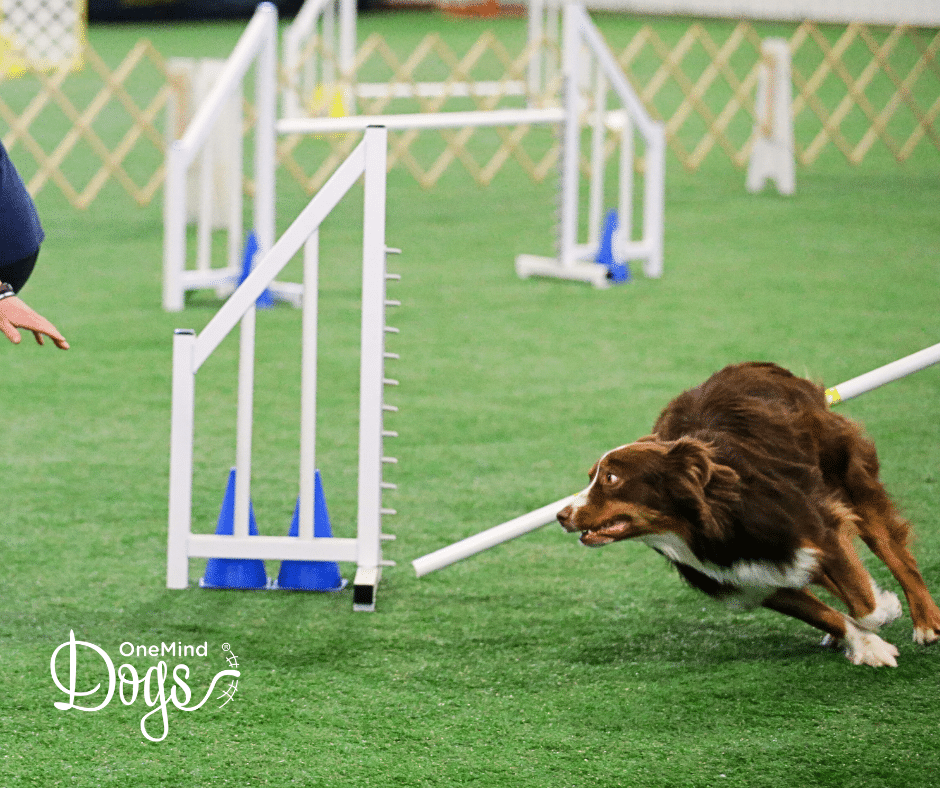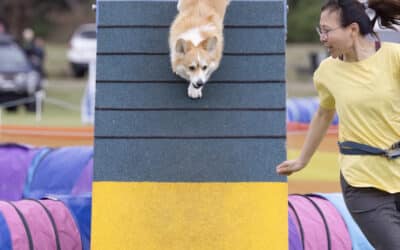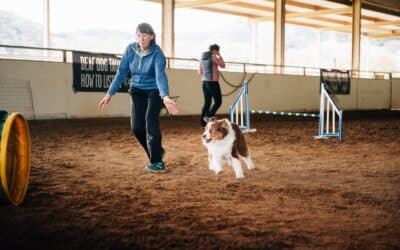Persistent bar knocking can be a frustrating and challenging issue in dog agility. Have you ever watched your dog joyfully sprint across an agility course, the two of you in harmony as you navigate a tricky sequence, only to be sidelined by an unexpected knocked bar? Whether your dog knocks bars regularly, or its a recent development, we have some tips for you!
This article aims to help you understand why bar knocking happens in agility, from your dog’s perspective, and how to prevent it. That said, we’ll cover the essentials here. But for an in-depth understanding and practical training techniques, we recommend watching our free webinar. It provides comprehensive insights into preventing and tackling bar knocking.
Let’s set the stage. The key to solving this mystery lies in evaluating four elements – physical ability, timing, understanding, and focus of our dogs during agility training. Keeping these factors in check and addressing any concerns promptly could make a significant difference in keeping those bars up! So, let’s “jump” right in!
1. Physical ability
Just like us, dogs can have off days, too. They might not feel their best or simply lack the energy to handle the physical demands of agility training. Especially when discussing activities that need them to twist, turn, and jump on a variety of different surfaces. So before getting down to serious agility training, we need to consider a few important things:
- Is your dog sore from a previous training session or injury?
- Is your dog fit enough to complete a full course of obstacles easily?
- Does your dog have physical limitations that might affect its performance?
- Is the environment going to make things more difficult for your dog today?
How to assess your dog’s physical state
So, how can we tell if our dogs are feeling up to the task? Well, keen observation is the key. Any changes in your dog’s behavior or movement might be red flags. Watch your dog during normal activity, and especially during warm-up exercises before your runs. Do they stretch more deeply on one side than the other? Are they favoring one side when turning? These sort of changes could mean your dog feels sore or uncomfortable, which can affect their agility.
You might have noticed that when your dog is unwell or sore, they tend to avoid some activities they usually love. Maybe they’re not as willing to jump on the couch as before, or you’ve noticed a grumpier mood than usual when they’re tired. As dogs age, their eyesight can also start to fail which is a major cause of bar knocking, as it becomes more challenging for your dog to judge the depth in their field of view.
These little things help you see if there has been a change from their normal behavior. Such hints could also be seen during training, where dogs who aren’t comfortable may hesitate near obstacles like weave poles, teeter, and the A-frame. They might even start taking wider turns than usual in an attempt to avoid discomfort.
The simple rule here: If something looks off during training – like sudden bar knocking – it could very well be because your dog isn’t feeling 100% physically fit and ready.
What to do if your dog isn’t physically fit?
While it’s paramount that we ensure our dogs are not in discomfort generally, it’s equally important that they are physically fit for agility training and competing if that’s what we plan to do with them. As good dog owners, it is our responsibility to consult the appropriate experts when it comes to the physical fitness and wellness of our dogs.
Unlike us, our pets can’t express their ailments verbally. This is where professionals like physical therapists, opthamologists or veterinarians come into play. They possess the expertise to understand and handle issues such as muscle building or tendon strains. When it comes to investigating bar knocking in your agility dog, a physical check up should always be the first step.
When to proceed with training?
The fitter your dog, the better their chances of cleanly performing all of the obstacle in agility. Think about it like this. Preparing humans for a marathon doesn’t start at the running track on race day. It starts way back with strength training, flexibility exercises, and gradually increasing our fitness levels. The same concept applies to our dogs as well.
If your dog carries a bit of extra weight, that could stress their joints more than usual during agility —not just bad for bar knocking but potentially harmful too over time. Keeping them in top shape should be a top priority.
Find a conditioning expert and work together to build a plan for your dog’s overall strength, fitness and agility, to help them perform at their peak.
2. Timing
When it comes to handling dog agility courses, timing is everything! It’s not just about how fast your dog can run or jump. It’s also about how well they can navigate the course based on your cues. If your cues are not timely, your dog is much more likely to knock a bar simple because they will need to adjust their plans mid-air!
Consider each move like a conversation between you and your dog. You cue them at the right time, and they respond by executing the maneuver flawlessly. And this ideal reaction relies on perfecting the ‘3Cs’ as mentioned in our webinar – Connect, Commit, Cue.
Connect – Establish a connection with your dog, if you can see them commit, your timing is better.
Commit – Watch for the moment that they are committed to the obstacle.
Cue – Once committed, give them information about the next part of the course using a handling cue.
In our webinar, we elaborate more on how clear instructions, correct positioning during actions, and sufficient experience can help dogs avoid bar knocking in agility runs.
Finding the perfect timing
In agility training, telling your dog what’s coming next and preparing them for it plays a vital role in their performance. This is where you, the handler, come into the picture. Oftentimes, whether your dog manages to clear the bar, or ends up knocking it, heavily depends on your timing of instructions.
Remember, tailoring instructions for each action has to be spot-on. Suppose you’re near a jump; cues should be given at least one stride before your dog’s take-off, so they have time to adjust their take-off point. If you give your information too late, the dog will need to try and adjust mid-air or after landing, often resulting in knocked bars or slips and falls onto the dog’s shoulder.
Timing of handler movement
Movement is the number one handling element that your dog relies on, to get through and agility course accurately. The challenge lies in understanding when to use different handling techniques based on the sequence you and your dog are facing. For instance, determining when to use front or blind crosses can greatly influence your dog’s ability to jump and turn efficiently.
Keep in mind that dogs cannot adjust easily mid-air. Using appropriate handling techniques becomes pivotal since an incorrect or late signal from you might confuse them, leading to potential injuries and unintentional bar knocking.
Learn more about the 7 handling elements used in the OneMind Dogs method:
3. Understanding and distractions
Did the bar fall again? Don’t get angry or discouraged. It’s important to know that dogs don’t do things wrong on purpose. If your dog is struggling with clearing jumps, and you’ve ruled out any physical or timing issues, it’s time to start training some extra skills! Dogs learn best when we teach them what we expect, clearly and consistently.
How to help your dog keep the bars up, even under distraction
Training your dog for agility is not one huge leap but many small steps combined. Firstly, make sure you have covered all of the important Foundation skills that your dog needs to be successful at agility.
Helping your dog understand how to negotiate obstacles in a diving-style jump for tight turns is also a powerful way to prevent bar knocking in agility. There are several handling techniques that help your dog learn to turn in this way, we discuss those in more detail in our post on collection and tight turns.
Another big cause of bar knocking in agility is that the dog is distracted by the handler’s movement. This is especially true for handlers who like to use a lot of arm motion when handling their dogs. Teaching your dog to clear the jump, even under distraction, may help prevent bar knocking if this is an issue for your dog. Here are some videos on advanced jump skill exercises.
4. Handler focus vs obstacle focus in agility
Finally, let’s talk about one last thing that could play a big part in bar knocking: focus. Yes, our dogs can sometimes be too focused on us, their beloved handlers!
If you notice your dog staring a lot at you during agility training, or rushing past obstacles to catch you, they may be too handler-focused. And this could result in them knocking bars as they race to keep up with you instead of focusing on their task of completing the obstacles.
Focus exercises for bar knocking
Dogs that are aroused by movement, such as herding breed dogs, tend to struggle with focusing on the obstacles when the handler is running. If your dog has too much handler focus, doing some obstacle focus exercises will often go a long way to resolving bar knocking. Are you not sure if your dog is too handler focused? A handy test for this is what we call the ‘no chasing game.’ This test checks if your dog is able to stop and get a delicious treat or awesome toy instead of just madly chasing after you.
This might seem a bit surprising, but it’s actually possible for our dogs to drop bars simply because they are not looking at them! When their main focus becomes the handler or other distractions, it’s very likely they’ll knock bars. Watch the video below to see how the no chasing test works:
If your dog tends to knock the second bar in a spread hurdle / double jump, there’s another simple but effective exercise to get your dog to focus on the actual bars, know as wing alley training. This will train your dog to attribute less importance to the wings and really pay attention to where it matters: the bar!
Environment and Other possible distractions
Apart from focus, another problem could lie in the visibility of bars. In a complex course full of obstacles, the bar can sometimes blend in with other objects, causing your dog to miscalculate their jump. The color of the bars can also have an effect on your dog. If you are at a competition where many dogs are knocking the same bar, consider the dog’s perspective and see what is in the background.
If the grounds are a bit slippery, your dog may also have more trouble getting a clean take-off, potentially knocking the bar as they stabilise their jump mid-air. Similarly, thick, long grass could make it more difficult for your dog to get enough lift which may change their jump style.
In short – keep a note of any bar knocking during training and competitions and see if you can identify a pattern, whether it be environmental conditions or a specific sequence or handling technique that’s causing the issue for your dog. Dogs are great coaches, take any mistakes as feedback and see what you can do to make things easier for your dog. Contact us for help if you’re having trouble solving this issue by yourself.
Conclusion
So, there you have it—our guide to preventing bar knocking in agility dogs! We’ve chatted through the different aspects involved, from your dog’s physical health and abilities, the importance of proper timing and understanding, right through to the key role focus plays.
But remember: this article is just a brief introduction. Our free and detailed webinar dives in more on this subject. If you found this post helpful, then be sure not to miss that.
Ready for more? Sign up for OneMind Dogs now! Not only will you make your dog’s training more enjoyable—but bar knocking could become a thing of the past.



